
How to Create a Buyer Persona in 5 Steps (+ Free Templates)
Buyer personas refine your inbound marketing efforts. They streamline the sales process. And they can even improve customer and product support. This guide walks you through buyer persona templates and shows you exactly how to create your own personas to use them to make the most of your inbound campaigns.

Get a PDF Plus Our Bonus Persona Template
Looking for templates that are specific to your industry?
Fill out the form below to access our industry specific templates & your guide.
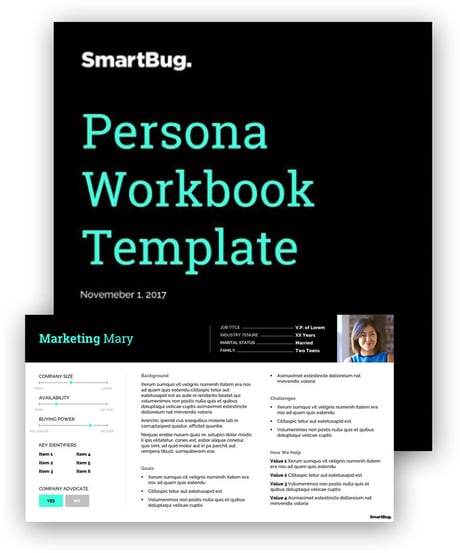
Chapters
What Is a Buyer Persona
How to Build a Persona
How to Use Personas
Advanced Persona Development
Conclusion
What Is a Buyer Persona

A buyer persona is a representation of your target customer. It’s a picture you paint based on research and interviews with actual customers. It goes beyond basic demographics to include the intangible elements that make a person tick. Persona development is paramount for the success of an inbound marketing program, no matter the size or scope of your business.
While personas are heavily used by marketing, they should be embraced across your entire organization.
Buyer personas help teams allocate resources, attract leads, and understand what drives people to make purchases. They’re the type of customer that remind you why you got into marketing or sales in the first place.
Personas help answer the following questions:
- What type of content is most likely to generate a response from a particular type of customer?
- How does your ideal customer prefer to engage in the sales process?
- What problems do customers need to solve, and how does your business help them?
In this ultimate guide, we’ll review the nuances of personas. We’ll outline exactly how to build a persona and provide specific interview questions your team can use. And we’ll demonstrate how to use them across your organization.
By the end, you will understand why personas are so important, the impact they have on your bottom line, their connection with inbound marketing, and how to create them successfully.
Want to see some examples of buyer personas to get your creative juices flowing?

Why using personas is important
Persona development is a crucial first step for any campaign. No matter how large or small your business is, you want to get the most from your inbound marketing budget.
Buyer personas embody the type of customer that gives you the most revenue, with the least opposition, over the longest period of time.
Without this fundamental research, you will not truly know what attracts new leads and drives them to make a purchase, potentially leaving profits on the table.
This research extends to all aspects of an inbound marketing campaign and will guide you through every decision you make.
The time and effort you spend writing blog articles and white papers will pay off much more if your content is created with a persona in mind.
Buyer personas embody the type of customer that gives you the most revenue, with the least opposition, over the longest period of time.
Additional reasons to use personas for inbound marketing include:
Objectivity
It’s easy to fall into the trap of assuming that you (the marketer, salesperson, or business owner) are the target audience. You are only one type of customer; yours is not the only persona you must reach. Developing multiple personas allows you to empathize with all your customers so that you create messages from multiple perspectives, not just your own.
Focus
When you know what makes your customer tick, developing the content that is likeliest to speak to him or her is easier. Without this ability to focus your marketing message, you will dilute your efforts and miss opportunities. Personas also ensure that everybody on your sales and marketing teams shares a common understanding of your customers.
Strategy
One of the biggest mistakes you can make is to assume that you know what your customer wants and needs. The only way to truly know this is to ask questions that help identify the gaps your product or service is able to fill. Once you know what problems your customer needs to solve (whether he or she knows it or not), you can craft more effective inbound marketing strategies.
The connection between personas and inbound marketing
Inbound marketing is used primarily to capture new leads and convert them to customers. And an essential component of inbound marketing is the utilization of online content to attract potential customers.
Many different types of content can be developed, and in many cases, marketers might target your customers by using a combination of approaches, including:
- Blog articles
- Online videos
- Podcasts
- White papers
- E-books
- Newsletters
- Social media posts
- Online advertising
Without a comprehensive understanding of your customers, you’re taking a shot in the dark with your marketing materials.
Yes, you might make educated guesses that produce some positive results. But taking the time to develop personas is a much more cost-effective solution.
Creating inbound marketing campaigns with personas in mind focuses your efforts and increases your return on investment (ROI).
Persona development helps you determine:
- Which format(s) will garner the best response
- Which media channels are likely to reach the most potential customers
- The tone you should use when writing content or communicating with customers
- The types of content that will attract the most new leads
- The calls to action that will generate the best response rate
What industries should use personas?
Businesses of all types can use inbound marketing to grow sales—which means that virtually any type of business can benefit from persona development, from financial service providers to SaaS companies to senior care organizations.
These are just a few examples of the types of businesses that use personas:
- Business-to-business sales
- Business-to-consumers sales
- Service providers
- Manufacturers
- Consultants
- Online businesses
- Brick-and-mortar retail stores

In other words, if you are in the business of selling a product or service to an individual or company, you must understand what drives your customers to make a purchase.
Optimizing your marketing efforts with persona development is the best way to ensure your messaging resonates with the people that keep your company profitable.
Take Your Buyer Personas to the Next Level
Templates for SaaS Companies
SaaS companies need specific buyer personas to expand their active user base.
Check out these SaaS specific persona templates to learn how.
Templates for Financial Services Companies
Want to deliver unique, compelling, and targeted digital content to people that can help your financial institution grow?
Download our Complete Buyer Persona Kit for Your Financial Services Company.
Templates for Senior Care Organizations
Make sure you are getting the right messaging in front of the right audience.
Download our three-part Buyer Persona Kit for Your Senior Care Company for everything you need to know about the role of personas in your marketing.
Buyer personas help you understand your customers in a human-centric way.
What’s a persona? What's not a persona?
What’s often assumed is that a persona is needed for every role encountered in the buying process. Or that the focus should be on job titles or roles. Or that the terms “buyer’s journey” and “buyer persona” are interchangeable. These are all misconceptions. Buyer personas are not roles, market segmentations, or the actual buyer’s journey itself.
Instead, buyer persona development is intended to glean insight from situations and scenarios.
Buyer personas help you understand your customers in a human-centric way. Their goal is not to profile; rather, it’s all about uncovering behaviors.
Ultimately, the aim of buyer personas is to gain an understanding of the range of behaviors behind why people attempt to accomplish goals.
To further explain the nuances, let’s review some differences between personas, demographics, and job titles.

Demographics vs. Personas
Market research reveals essential information about the people who are likeliest to purchase your products or services. For example, one customer type might be:
- Caucasian
- Female
- Age 25-35
- Employed
- Single
- Urban
These are useful facts that you certainly need to know. However, persona development provides a deeper level of understanding that enables you to truly speak to your target customer.
Using the example above, an effective interview with a customer that fits this description might also tell you that:
- She doesn’t own a car, so the ability to make online purchases is important to her.
- She has disposable income but still likes getting a good deal.
- She uses her smartphone more than her laptop.
- She would rather interact by email than by phone.
- She uses social media to stay current on trends
While demographics include the basic information about a person, personas dig deeper and provide insight into the personality of a buyer.
For example, targeting employed, urban-dwelling, Caucasian females who are single and between the ages of 25 and 35 paints a vague, ambiguous picture of a young professional. This won’t help you refine your sales and marketing processes.
It’s important to narrow your scope. Personas focus on what makes your prospects who they are and what drives them to interact with your business.
Personas focus on what makes your prospects who they are and what drives them to interact with your business.
Job Titles vs. Personas
Job titles and categories are different from personas because they’re more contingent on specific relationships with a product, industry, or company.
It’s easy to simply write someone off as a CEO or CFO and assume that he or she is inherently different based on these job categories. While this may be true if you’re selling financial software, it may be irrelevant if you’re a services company where the primary buyer is the HR team and the executives control the budget.
Job-title-based personas are a potentially perilous mistake.
Many professions and jobs share similar goals, habits, or personalities that make them one persona for a specific company, not multiple. To illustrate this point, let’s revisit the situation above. Because an executive can be a financial sponsor, and because executives often have shared strategic goals and vision, it makes sense to combine these roles into an overarching “Executive” persona.
Resources
5 Questions to Ask Your Customer Support Team to Help Build Buyer Personas
Read MoreHow to Build a Persona
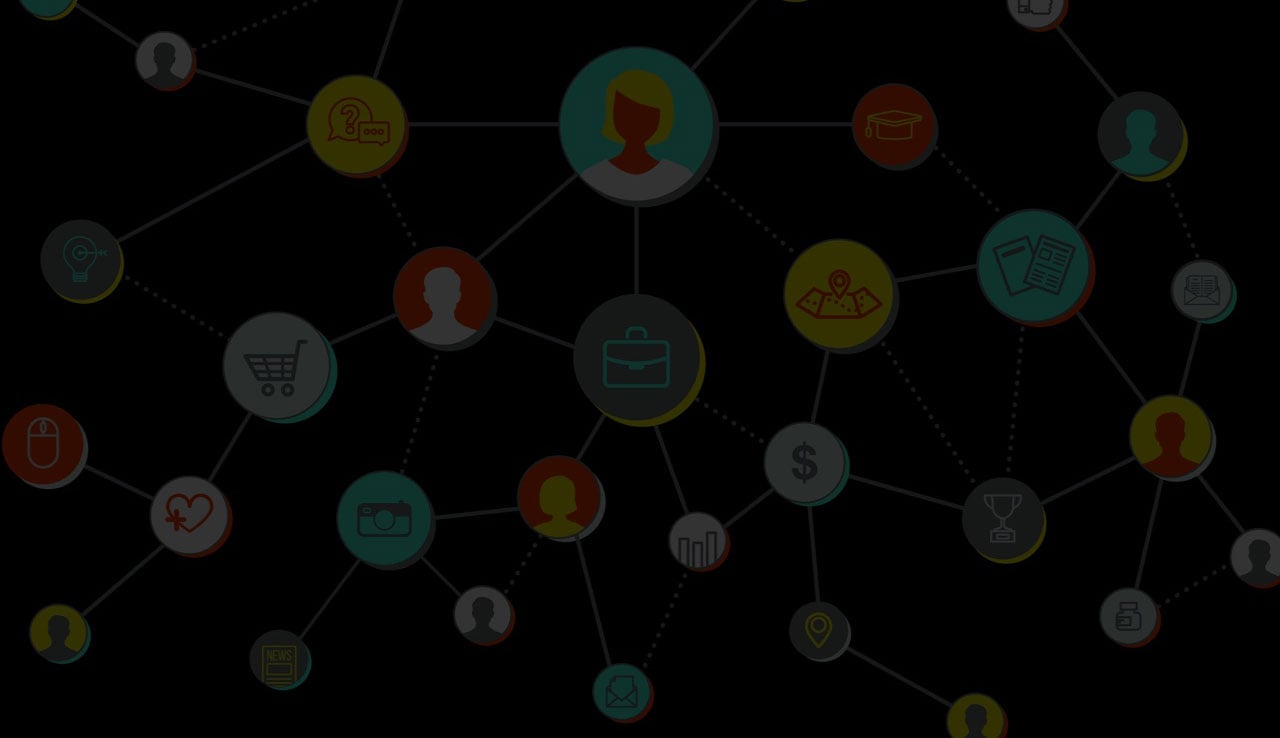
Finding out what makes a person tick is no small task. Where do you start? What questions do you ask? How can you draw conclusions from the responses you receive? The following three-phase persona development process will help guide you through the steps toward better understanding your customers.
Internal conversations
Before you begin building personas, it’s important to facilitate internal conversations to ensure that everyone is on the same page. From sales to marketing to customer service, each department can bring something to the table.
Consult your internal team about customer pain points, goals, and common behaviors—before you begin building personas.
The Kickoff Call
The first step in the persona development process is a kickoff call with the sales, service, and marketing teams to explain what personas are and to get their input about the types of customers that make purchases.
The goal of this meeting is to explain personas in language that makes sense to your disparate departments. It’s up to you to prepare interview questions that can help you uncover valuable information.
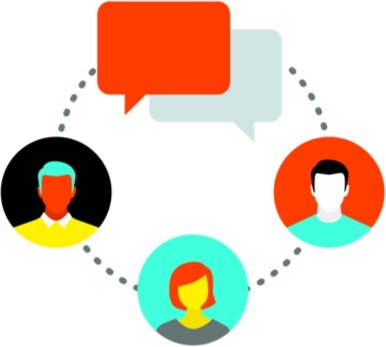
Internal Interviews
Sales Team Interview
Your sales team interacts with customers every day.
Your salespeople will have some of the best insights into which factors influence whether a prospect makes a purchase or not. They will know what questions are commonly asked, the objections that they frequently face, and the unique selling propositions that are most meaningful to your target customer.
However, they may not know how useful this knowledge is. Use these interview questions to draw out this valuable information as you develop personas:
What types of customers do you typically meet?
Have your salespeople describe the various types of people they interact with on a daily basis. Are they business owners, stay-at-home moms, athletes, or elementary school teachers? You likely sell to multiple customer types, so don’t settle for just a single response. Make sure that salespeople answer these questions in detail. The more detail, the better.
Why do different types of customers typically make a purchase?
Different people buy the same products for different reasons. One woman might purchase an expensive nail polish because it’s her favorite color and the brand she always uses. On the other hand, a different customer might purchase the same bottle of expensive nail polish once in a lifetime as an indulgence or, perhaps, because it is on sale. These are two different customer personas, and your salespeople should know how to distinguish between them.
What reasons do customers cite for selecting your business over a competitor?
Often during the sales process, customers will mention the benefits or drawbacks of your company versus the competition. Your salespeople should know which product features or service offerings are the most meaningful to different customer types.
What are the most common objections you hear?
Why do potential customers not make a purchase? What objections must the salesperson overcome to close a sale? Understanding the negative perceptions that your customers feel is critical when creating marketing messages that are designed to increase sales.
Working with your marketing team during the persona development process will help you better understand whom you need to reach
Marketing Team Interview
Your marketing team also knows how your customers behave, typically from indirect interactions rather than direct ones.
For the purpose of inbound marketing, you are primarily interested in the ways your customers find your company online.
Even if your sales process goes offline after an online lead is captured, working with your marketing team during the persona development process will help you better understand whom you need to reach and how best to reach them.
What technical and demographic information do you have about your website visitors?
Your marketing team will have valuable analytical data from previous and current inbound marketing campaigns, including important information such as:
- Which pages customers visit on your website
- Which pages they leave
- Whether or not they abandoned a shopping cart
- The lead generation tactics that had the greatest impact
- The most viewed content on your site
- Where your customers are located
- The keywords and phrases that customers use to reach your site
- The call to action that generates the best response
Analytical data can tell you where your online visitors are located, how they reached your website, and even important demographic details. Your marketing team may also have insights based on customer surveys, lead capture forms, and other information sources that will help you paint a picture of your target audience.
How do you currently market?
What are the existing components of your marketing strategy, and how effective are they? Which online marketing tactics do you use? What other types of media do you use? When developing personas, knowing how your various customer types reach your business is important. You may find that certain customers are more inclined to click on an online advertisement, while others are likelier to find your company through a blog post or downloading a white paper.
Equally important is thinking about what is missing from your current marketing strategy. You may find that some personas are underserved because you aren’t using the tactics that are likeliest to reach them.
Describe marketing campaigns that have been the most successful.
Most marketers carefully track the success or failure of campaigns and other activities. The most common metric used is the ROI for each campaign. Although this is certainly important, it is not necessarily the only metric that matters for inbound marketing. Pay attention to other measures of success, such as:
- Which online campaigns received the most impressions
- Which advertisements received the most clicks
- Which piece of content was downloaded the most times
- Which coupon code was used the most
- Which link was clicked the most in an email newsletter
Describe marketing campaigns that have failed.
In marketing, knowing what doesn’t work is always useful. Find out which messages garnered a negative response or simply fell flat.
Which blog posts have received the most traffic?
Find out what content attracts the most attention. Are there any common traits between the most popular posts? Do customers prefer informative posts, recaps of industry news, infographics, or other types of content? Knowing how your customers spend time with your content can help you understand what they find most valuable.
What are the most frequently asked questions from customers?
Do they want to know how a product works? Are they looking for more general information about your industry? Do they want to know your refund policy before they buy? These are the types of insights and customer behaviors that can help you develop personas.
Which page on the website receives the most impressions?
Getting eyes on a page means that you attracted a potential customer for some reason. Just because you didn’t close a sale does not mean that you weren’t successful in some way. Possibly, your site navigation is too confusing, your call to action wasn’t strong enough, or some other factor played a role in losing the sale. Focus on what brought customers to the page in the first place to help you develop personas, improve inbound marketing, and optimize your sales process.
Customer Service Team Interview
What questions do prospects ask?
There are hundreds of questions that prospects may ask before making a purchase. Because they’re in the research phase of their decision, they may ask about your product’s support model or warranties, or how you’ve benefited others in the past. At this point, they want to talk to people who have built the product.
What are current customers saying?
It’s safe to assume that your current customers had their questions answered. Working backward from here not only helps illustrate what worked but also what their questions are based on their current experience. This helps uncover questions that those customers used to apply your product to their business model. It also helps build personas based on what customers want to know after buying.
What skill sets do customers need in order to use our product?
Your support team understands the skill sets of your customers. Uncovering missing skills and competencies can help you better understand customer strengths and pain points—which contributes to more thorough buyer personas. Ultimately, this helps you align content around specific challenges.
What are customers saying about our product?
In addition to customer challenges, your service department also receives compliments about what’s working well. Because it’s on the front line of communication, your support team is often the first to hear these accolades. It’s important to document all sentiments—both positive and negative—to inform your personas.

Customer conversations
Information gathered from your internal team provides a good starting point for understanding your customers. But the only way to really get inside their heads is to speak with them directly.
After gathering information from your sales and marketing teams, validate the assumptions you have made by interviewing actual customers.
Asking questions that enable you to understand their behavior and the challenges they face helps refine content and marketing messages.
Think of persona development like the scientific method. Your internal conversations help form the hypothesis of who your personas are. Interview customers to look at your hypothesis critically and see if you are able to disprove or prove it.
Use this information to tailor your products and services for different personas. You won’t know what they want (or don’t want) unless you ask.
Your objective is to understand customers’ behavior. Craft your interview questions with this in mind so that you can develop a comprehensive persona profile.
Choosing Interview Candidates
It’s important to talk with a range of customers from disparate backgrounds, buying situations, and target markets.
Ask your sales team to help you select a few candidates from each buyer persona group.
Don’t focus on one persona; you want to draw from the full spectrum of customer types. Ideally, the best type of interviewee is one of the following:
- People who have chosen to buy your solution
- People who have chosen not to buy anything
- People who bought from competitors
Because they have just been through the buying process, these customers can provide specifics about how they evaluated your solution. They can provide insights into their attitudes—both positive and negative—toward your competition.
Finally, they can detail each step in the process and the resources they used to make a decision.
Don’t focus on one persona; you want to draw from the full spectrum of customer types.
How to Conduct a Client Interview
Conducting a client interview requires dexterity and tact. Review any existing information you have about your client to build rapport out of the gate. It’s your job to make the client feel comfortable.
Be as transparent as possible and explain the goals of your conversation.
Finally, pay close attention to the way you form interview questions.
Open-ended questions provide much more valuable information than a simple yes/no query. For example, asking customers if they would purchase your product or service will not give you much valuable information. Instead, asking them exactly why they would or would not make a purchase results in a broader range of responses.

What Questions Should You Ask?
Every industry is different, but some customer characteristics and behaviors can be universally applied when developing personas.
Whether you sell vacuum cleaners or accounting services, getting the answers to some basic questions is the first step in understanding personas.
Looking for questions you need to ask when creating your buyer personas? Use this template to guide you:
10 Questions You Should Ask When Developing Buyer Personas

Demographic questions
The basic details about a customer won’t paint the entire picture of a persona, but they are an important starting point:
What is your marital status?
Single individuals and couples face different challenges in life and have different household needs. You might want to know if you’re marketing to a husband that wants to please his wife or a bachelor who wants a fast and easy way to make meals.
What is your household income level?
You want to know which customer types have more or less disposable income so that you can tailor marketing messages. Consider providing income ranges so that your customers are more comfortable giving you this type of information.
Where do you live?
A customer who lives in a city with public transportation, cultural activities, and multiple shopping options has needs that are different from those of one who lives in a more secluded area. Various parts of the country also have differing customs or preferences.
Are you a homeowner or renter?
Customers who own homes generally carry more financial responsibilities and purchase products and services that are different from those that a renter purchases. Also, knowing the type of building in which a consumer lives is useful in determining which of your products or services to market to a particular persona.
What is your gender?
Although both men and women use many of the same products and services, the reasons they select one company over another can be dramatically different.
What is your age?
Customers in different stages of life face unique challenges. Knowing the age range of your target customers will help you craft marketing messages for each segment of the population.
Do you have children?
How many and what ages? Families with children have lifestyles different from those who do not. Knowing the ages of the children in the home will give you a better idea of the daily challenges your customers face. Do they need to feed three hungry teenagers, juggle an infant and a toddler, or keep up with tween trends?

Career questions
If you market products or services to other businesses, you must know about the industries you serve and the customer types with which you will be interacting.
Does the sales process begin with an entry-level employee or a business owner? What factors do customers consider when making certain types of purchases? This information is also important for business-to-consumer marketers, because a customer’s work life (or absence of one) significantly influences the overall persona:
In what industry do you work?
A florist has needs different from those of a farmer, even if they purchase the same type of fertilizer. An office manager who works for an environmental nonprofit will likely purchase types of office supplies different from those of one who works for an oil company. Just because two different customers make the same purchase or need products in the same category, it does not mean that they share the same persona.
What is your current job level?
A blue-collar laborer faces challenges different from those of a CEO. A purchasing agent who needs approval from a manager will respond to marketing messages different from those of a small-business owner who does not go through multiple channels to make a purchase.
To what job level do you aspire?
Job satisfaction plays a major role in customers’ lives and influences the choices they make. For example, a marketer who sells language-learning programs would benefit from knowing that a particular persona is interested in an international career path.
How long have you been in your current position?
The length of time that customers stay at a job can tell you about their loyalty to a company, their desire to climb the corporate ladder, or a possible aversion to change. While some personas are keen to try new things, others like to stick with what they know. This type of behavior often crosses multiple areas of life, including their purchasing habits.
What is your education level?
In addition to getting a better sense of customer's level of knowledge, you might also learn that they are paying off student loans from college. Customers who didn’t finish high school are less likely to respond to certain types of marketing messages. Knowing a persona’s education level can also help you decide what inbound marketing tactics to use. For example, a persona with a high school education may click on a link to a video but be less likely to download a white paper.

Daily life questions
Understanding how customers spend their days will help you learn what they find frustrating, how they prefer to spend free time, and the other choices they make on a daily basis:
What does a typical day look like for you?
This open-ended question gives your customers the opportunity to share the behaviors that they deem most significant. Allow them to describe the entire day and then ask for more details about the areas that are important to you.
How much time do you spend at work and at home?
If your customers feel that they don’t get enough time at home, perhaps you offer a product or service that can help them get the most from their time away from the office. On the other hand, a stay-at-home parent might be interested in coupons for local restaurants so that he or she can get out more on a tight budget.
What do you do for fun?
Although many people spend a good portion of their day working, this is not necessarily the only aspect of life that defines them. Do your customers like to surf the internet, go to the movies, participate in a book club, golf with friends, or watch sports on TV? Understanding how your customers spend their free time will tell you what is important to the various different personas you are trying to reach.
Who are the people in your life who are most important?
Do your customers most care about their children, parents, spouses, or friends? Perhaps their pet is the first answer that comes to mind.
What types of vehicles do you own and why?
A customer who bicycles to work every day will have a perspective different from that of a customer who drives a diesel truck. The mom with the minivan is likelier to respond to a marketing message about practicality, while the CEO with the sports car might respond to one about indulgence.
What do you watch on television?
Do your customers like to stay current with international news? Do they watch cartoons with their children? Do they like game shows? Perhaps they don’t watch television at all. You can learn a lot about a persona from the television choices that an individual makes. Offering an online game is the best way to attract a certain persona, while another might be drawn to an ongoing series of videos.
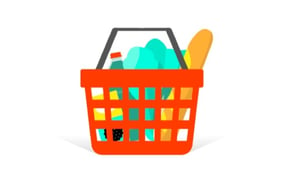
Consumer habit questions
Consumer behavior can be difficult to predict, which is one reason why developing personas is so important. Ask your customers how they make purchasing decisions so that you can reach them more effectively:
Where do you go to learn about a product or service?
Everybody has to do a little research now and then. Some consumers immediately reach for a smartphone to get online customer reviews of a product, while others call a trusted friend or relative for even the smallest purchases.
What offline resources do you use?
Is there a local product guide or coupon book that they keep handy? Do they subscribe to Consumer Reports? You must ensure that your inbound marketing strategy accommodates the personas that do not use the internet as a first resource.
What online resources do you use?
Some consumers rely on a handful of trusted blog writers for recommendations, while others just click on the first result of a Google search. If resources such as Angie’s List are the first stop for certain personas, you need to know about it.
Where do you prefer to do your shopping?
A young, single woman who is busy with her career might buy everything online, including groceries. Ask her specifically where she shops and why. On the other hand, another customer might enjoy window-shopping downtown. In this case, knowing what draws that customer into the shop to make a purchase might be useful..
How do you prefer to interact with vendors?
Technology has changed the way marketers and salespeople interact with consumers, but not every consumer moves at the same pace. One customer may prefer a web chat to pose a question about a product, while another would rather pick up the phone and call customer service or schedule an appointment in person.
Whom do you ask for product/service recommendations?
You want to know who has the most influence on your customers. If they want to know which shampoo to buy, do they ask their hair stylist, their best friend, or their mother? Does a celebrity endorsement carry any influence?
How important is it to get a good deal?
One consumer might wait for a restaurant to offer a coupon on a daily deal site, while another would never dream of even joining such a site. Offering a deep discount is an excellent way to attract some personas but could possibly deter others.
What types of mobile devices do you own?
A persona that uses a tablet or smartphone on a regular basis will be more inclined to regularly visit your site if it is optimized for these devices.
What types of indulgent or luxurious purchases do you make?
One persona might occasionally indulge in a manicure, while another gets one on a weekly basis. Perhaps one of your customer types considers a trip abroad a worthwhile indulgence, while another splurges a few times a year by going to a fancy restaurant.

Pain-point questions
It’s important to understand what makes them frustrated, uncomfortable, or anxious—so that you can develop solutions to remove the pain.
By understanding your customers’ pain points, you’ll be able to predict their needs before they even exist.
Mentioning key pain points across marketing messaging and client communication creates rapport, trust, and transparency:
What is the most frustrating part of your day?
Waiting in line for morning coffee. Filling out expense reports. The frustrations of personas tell you more about what makes them tick. Perhaps they would benefit from a mobile app that your company offers or a white paper about how to improve workplace efficiency.
What is the worst customer service experience you have ever had?
Was it the overbearing salesperson, the long wait time on the phone, or the email full of spelling mistakes? Asking what a customer’s best experience was is also worthwhile in getting a full picture of each persona’s preferences.
What regular activity do you find stressful?
The daily commute, paying household bills, making dinner for the whole family, and getting the kids to school on time may be mundane tasks. But for many people, this small stuff adds up to become stressful.
What makes you nervous?
Perhaps you learn that a consumer has some social anxieties that make him or her less likely to go to a retail store to get answers to his questions. Promoting a free webinar might be the best way to reach this persona so that he can get all the information he needs without the pressure of an in-person interaction.
What is the fastest way for somebody to make you angry?
Consider a situation where a persona can’t stand it when somebody lies or tries to deceive him or her. How do you think he would feel about a coupon offer with several lines of small print at the bottom?
What is your least favorite part of your job?
Let’s say a persona manages 10 people, but really doesn’t like giving performance reviews. Asking him or her to complete a survey or provide a product review is not the best way to attract her attention.
What is the worst job you can imagine?
For some personas, the idea of sitting behind a desk all day terrifies them. On the other hand, manual labor is unappealing to other personas. You want to know what types of behaviors each customer type wants to avoid.
What purchase under X dollars did you most regret?
Select a dollar amount that corresponds to your industry and find out why customers were regretful. Did they feel that they didn’t get value for their money? Did the product not last as long as they had expected? Did they feel deceived by the product description?
What do you worry about?
Are your customers worried about their mortgage payments, whether or not their children will get into college, or how they will take care of aging parents? What do you provide that can help ease their minds?
What accomplishments are you most proud of?
Learn about the obstacles that your customers have overcome and the challenges they have faced to achieve success. You will also learn much about what customers value. For example, if they are proud of raising a child, family is clearly important to them.
What are the top three things on your bucket list?
Find out what a customer wants to do in life. This information will give you insights about the activities that customers feel they are missing out on, and, again, you will learn more about what they value most.

Industry-specific questions
The interview questions listed above will get you started on developing personas for each of the customer types that typically make purchases, but to get the most from the persona development process, you need to ask industry-specific questions.
Remember, the people you are interviewing are already your customers. They have made purchases (and not made purchases) for a reason:
What are the most common challenges related to your industry?
If you are a software developer, you can expect customers to ask questions about version upgrades and other technical issues. If you sell bubble gum in bulk to grocery stores, customer complaints or concerns will be of a different nature, possibly about packaging or the ordering process. This part of the persona interview should be customized. Ask the types of questions that will elicit clear responses about challenges unique to your industry.
What value is typically associated with your industry?
Find out what your customers value when they make purchasing decisions related to your industry. The accounting professional might discover that customers appreciate when tax codes are explained simply, while the candy manufacturer could learn that its buyers want an automated sales process that can be completed online. Ask your customers what they look for in a company when making purchases.
What is the preferred type of sales experience in your industry?
Customers who are looking for tax preparation services have several options. They can search the Yellow Pages and call the company with the most compelling advertisement, look online for the most highly recommended firm, or ask friends for referrals. What type of sales process do they prefer? Do they want to see a list of customer referrals and testimonials? Do they want to interact via email to schedule an appointment?
What are the most common objections to your product or service?
Find out why your customers choose not to buy your product or service. Some personas might be waiting for a better deal, while others need to shop around before committing to a purchase. Perhaps a 30-day trial period will ease the mind of a persona that is reluctant to commit to a purchase.
What are the top questions asked by customers?
What questions most frequently come up after a sale has been closed? Do customers have certain expectations that are not being met? Is there an informational gap that you can fill either before they make a purchase or immediately following a sale?
What are the top questions asked by prospects?
When trying to close a sale, what questions arise most frequently? As previously discussed, your sales team may offer some insights into this question. You can also find out which FAQs get the most hits on your own website or browse public help forums for the most commonly discussed problems.
Synthesis and writing
How to Compile Data
When creating buyer personas, there are two sets of data to consider:
1. Qualitative data collected from internal and customer interviews
2. Hard data collected from web tools
There are numerous tools that can be used to analyze data and enhance persona development.
For example, Google Analytics can segment site visitors by keyword to uncover similarities in search traffic. Identifying where traffic is coming from helps teams group buyers into themes or categories and discern how they can present content offers to meet expectations.
Buying intent—which can include product demo requests, engagement rates, and email open rates—can also be leveraged to augment the persona development process. This helps organizations understand why prospects are choosing specific pieces of content.
Regardless, it’s important for your data to illustrate what people have in common.
You must be able to adapt this data for your whole organization. This means making sense of data and presenting it in a format that everyone can understand. Whereas analytics in bulleted lists can show correlations, often, it’s important to translate into story format so that disparate departments can use the data.
Elements of a Persona Profile
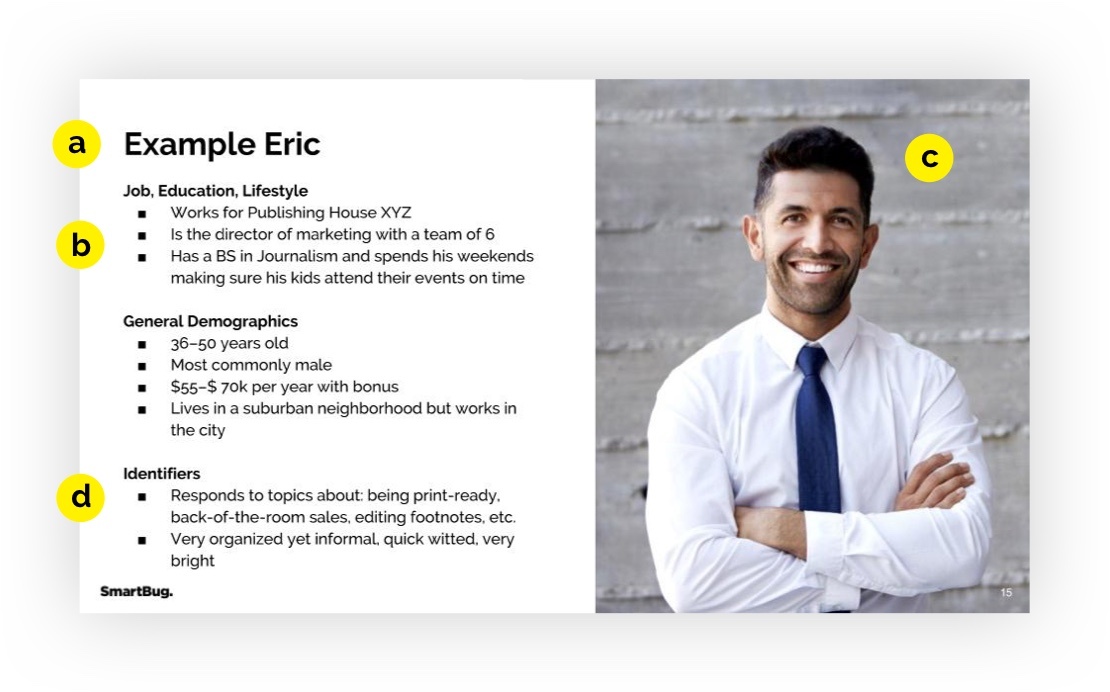
- Name: Many marketers use descriptive names such as Thrifty Tom, Elegant Annie, and Practical Pete. You can use these nicknames to help guide you as you develop new products, brands, and marketing campaigns. When your focus starts to wander, you can bring it back by asking questions such as “What would Practical Pete think of this offer?”
- Description: Each persona should include both demographic data and a narrative of the customer’s behavior. The narrative should include a description of daily life, common challenges, purchasing behavior, and other factors that influence how your sales and marketing teams will interact with this type of customer.
- Image: You will probably find it helpful to have an image that corresponds to each persona. You might find stock imagery that matches, or you may be able to use photographs of actual customers if they are willing.
- Identifiers: How will salespeople know if they are talking to a Practical Pete or an Elegant Annie? Provide a list of traits that help identify each different persona so that your team members can quickly select the most appropriate marketing messages when they encounter a potential customer.
How to Use Personas
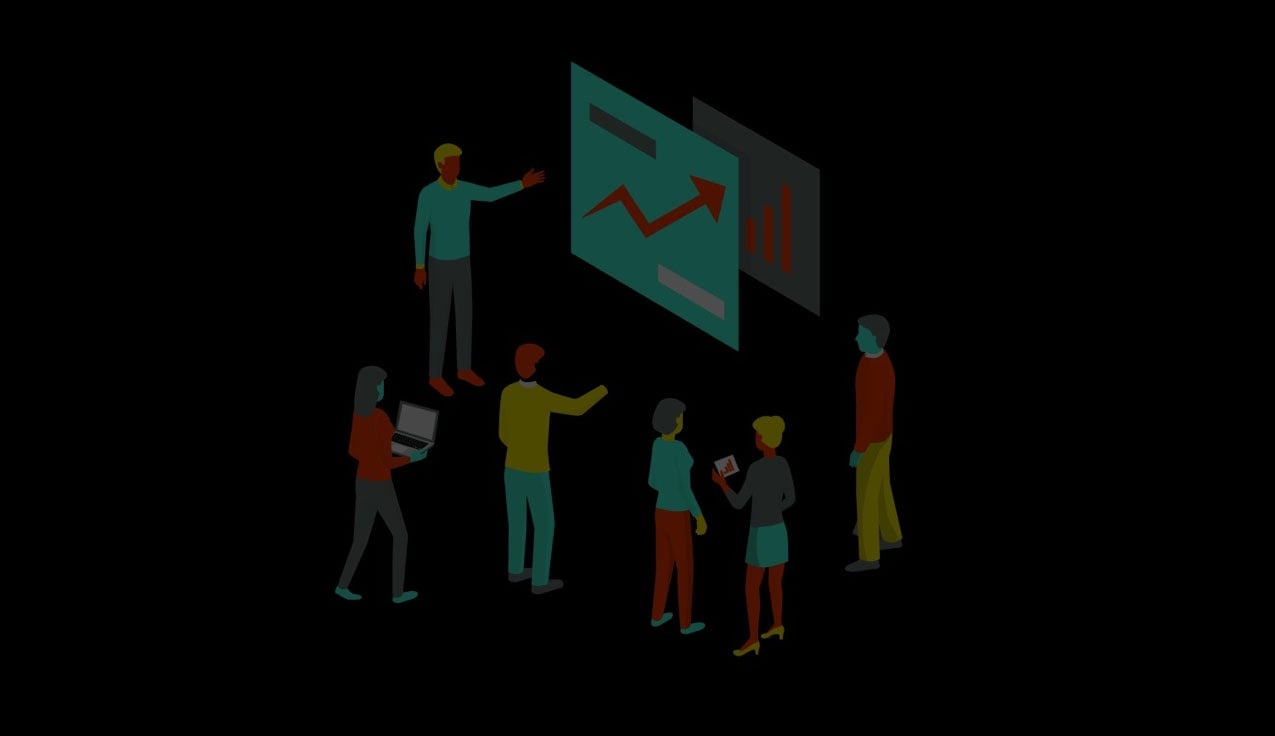
Who should use personas?
To make the most of your efforts, buyer personas should be used by marketing, sales, and support. As we’ve largely focused on marketing in this guide, let’s review how sales and support can make the most of buyer personas.
Sales
Because your sales team engages directly with customers, it can validate personas and make recommendations to marketing for improvements. Whereas marketing uses personas to attract the right people, sales uses them to engage with contacts.
Persona knowledge fills in the gaps so that they can be more helpful in the sales process, deliver value more quickly, and not waste that contact's time with irrelevant information.
Sales can use personas to gain a general idea of what’s important to a person before having a live conversation:
- What are his or her pains?
- How does he or she measure success?
- What does he or she value?
Persona development enables sales teams to tailor their communication efforts based on a lead’s preferences (such as text messages; phone calls; or long, detailed emails).
Finally, personas help illustrate if you have mutual contacts and illustrate how you can leverage these relationships to streamline the sales process.
Leverage personas to confirm a prospect’s values and communication preferences.
Customer Support
Like your sales department, your customer support team can leverage personas to confirm a prospect’s values and communication preferences.
However, support can take things a step further and interface with product development. In doing so, your product teams can build features around personas.
Consider the last several features you've created or products you've built. Ask yourself if you’re placing too much emphasis on catering your products toward a single persona. Or if you’re excluding a key persona. To help, ask yourself the following:
Whom are you building this new feature for?- How does this make a prospect’s job easier?
- How does it alleviate a prospect’s pain?
Ultimately, personas are the heartbeat of your organization and extend their influence into the sales process, customer support, and even product development.
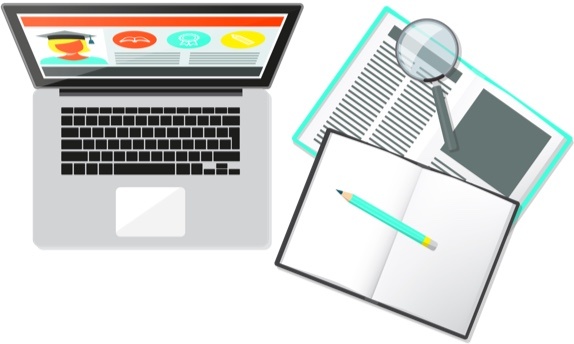
Personas and content development
Creating buyer personas is one thing; writing content that caters to them is another. Of course, every single blog post you write does not have to cater to each persona.
The purpose of having buyer personas is so that you can cater individual pieces of content to each of them. There may be times when a blog post caters to multiple personas, but you don’t have to make that your goal.
Writing to personas means solving specific problems. When writing a blog article, for example, you want to make sure you choose a title that will inspire specific people to read your piece. Research your title and the long-tail keyword you’re choosing to focus on that fits your persona.
Knowing what terms or phrases they use to talk about their problems can greatly help your search engine optimization and content creation. Do this by identifying questions your persona may want
It’s important to directly speak to your targeted audience. Write content that fits your persona and caters to his or her interests. This allows you to be more granular in what you’re writing about. Cater your language to your personas and use words that they identify with.
You should know if the personas use industry-specific terms or if they prefer more informal language. Applying the wrong language in your content can turn off specific personas, and, in turn, turn off potential clients.
Tying buyer personas to KPIs
Organizations can leverage data to make the most of buyer personas. Gathering the right data can tell you if you are missing a critical persona or if you misunderstood a key aspect of the persona. It can also tell you if you mistakenly prioritized a persona that isn't actually going to lead to real results.
Key performance indicators (KPIs) can help show whether a specific buyer persona is working or not. For example, tracking marketing qualified leads, sales qualified leads, opportunities, and even revenue from a particular buyer persona can all demonstrate success.
It’s important to consider whether KPIs should be aligned around buyer personas. For example, does your company need to grow a business segment that's only applicable to one buyer persona? In this case, aligning KPIs and buyer personas makes sense.
However, if your company is just getting started and needs all the leads and revenue you can get, it probably doesn't make sense quite yet.
Aside from quantitative data, however, discussions in the sales process can reveal how well your buyer personas are resonating.
While data can be utilized to create or revamp personas, nothing is more valuable than the qualitative data you get by just talking to these people.
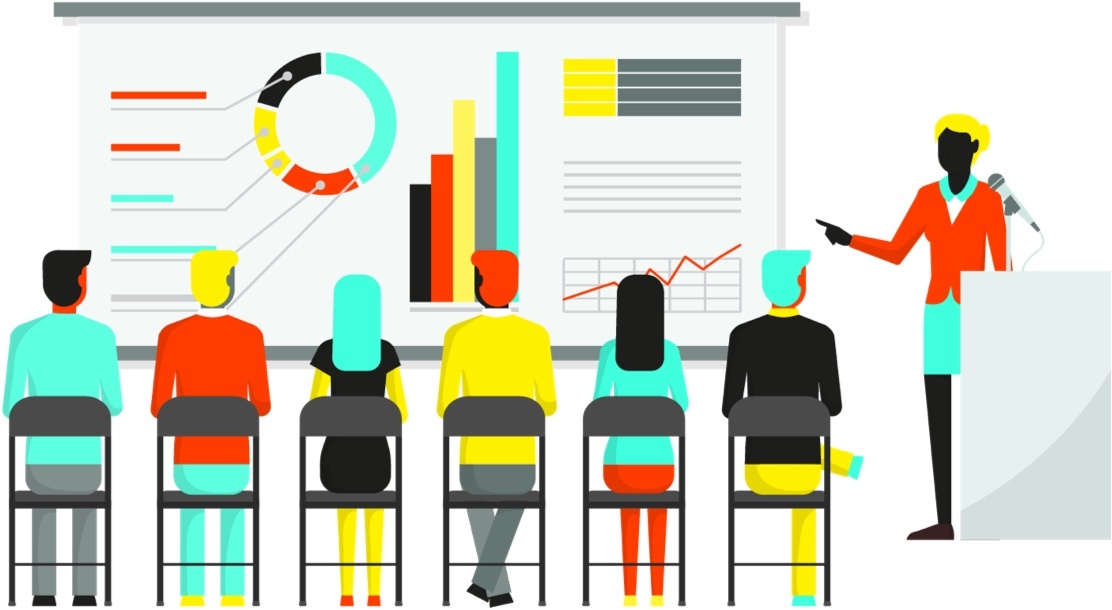
Analyze your personas at least once a year to ensure they are timely and keeping up with trends.
Updating and maintaining personas
When you're first creating personas for a new business, most of the process will likely be informed by client interviews.
As your business progresses and you increase your sales, you will uncover more about your core customers.
It’s important to go back and continually revise your buyer personas to ensure you're targeting your potential customers most effectively.
Personas are dynamic and should be periodically updated—especially if you have changed your products or services, have expanded into new territory, or have been faced with a dramatic shift in the economy.
Here are some common times to consider changing your personas:
- Buyout or merger
- Shift in business strategy
- Change in products or services
- After attending a trade show or industry event
At the bare minimum, you should analyze your personas at least once a year to ensure they are timely and keeping up with trends.
It’s also important to make sure you add any new marketing information you’ve garnered to your personas.
Starting with a template is a great way to ensure that you capture and present all the essential information.
Advanced Persona Development

Customer Personas
When a lead becomes a customer, is his or her journey over for your company? Or will you continue to work to delight him or her in hopes of turning him or her into a brand evangelist? (Hint: It’s the latter option.)
Companies constantly make the mistake of not understanding their customers’ concerns and motivations. Once you make a sale, your job isn’t over. It’s important to put in the effort to follow up with each customer to not only gauge his or her satisfaction levels but also to help gain some valuable feedback. These insights can be leveraged to inform your persona-building process.
Creating customer personas can help your team know what drives people after they convert. Below are some questions you can ask to dig into what is happening after the purchase.
- Have they ever had support issues?
- What are their experiences with your product so far?
- What do they wish your company was giving them more of?
By talking to current customers not only about their buying experience but also about their experiences as a customer, you can begin creating customer buyer personas that will help you delight your current and future customers.

Negative Personas
While buyer personas can help teams understand their audience and reduce costly interactions, it’s equally essential to bolster your strategy with negative personas. If buyer personas represent your target customer, then negative personas are pretty much the exact opposite. Negative personas save organizations time and money by identifying archetypes of whom you don’t want to sell and market to.
Customers who won’t work with your business will end up costing you far more—time, money, staff contentment, reputation—than they would have given you. Negative personas enable teams to segment out the bad apples by proactively identifying which types of prospects are a potential drain on resources. Finally, identifying negative personas gives teams a reason to cut ties with certain prospects.
To help identify the best personas, it’s essential to identify the ones that work with you in the first place. Successfully segmenting negative personas can result in a lower cost per lead and cost per customer, resulting in higher sales productivity.
Negative personas save organizations time and money.
Micro personas
While standard buyer personas differ based on the high-level goals, challenges, wants, or needs of an organization’s customers or users, micro personas differ based on more subtle features, such as preferred means of communication. One standard persona may have many micro personas, but each micro persona can only be a subset of one macro persona. Let’s look at a few examples of micro personas and how they relate to macro personas:
EXAMPLE 1: MARY

Macro persona
Marketing Mary is a marketing manager at a company with 50 to 200 employees whose main goal is to get more leads and prove the ROI of her efforts but feels like she doesn’t have enough hours in the day to accomplish everything she needs to.
Micro personas
- Young Mary: Highly tech-savvy, wants an automated solution for everything and is not afraid of using new technology to get the best results.
- Mature Mary: Not tech-savvy, intimidated by new technology, and takes a long time to warm up to new systems.
- Leader Mary: Has a large team to which she delegates all content creation tasks; is only in charge of high-level strategy/budget and hitting numbers.
- Tactical Mary: Has only one or two people below her and is responsible for doing many tasks herself.
EXAMPLE 2: PAT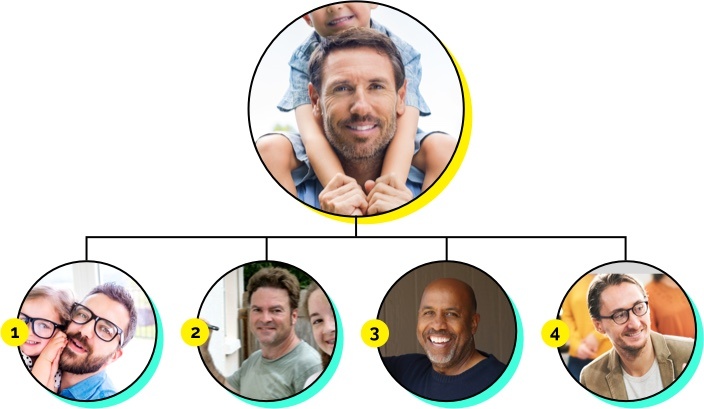
Macro persona
Stay-at-Home Parent Pat is a full-time parent to two school-aged children. Pat’s spouse works full-time to support the family. Pat’s goal is to be as present and involved in the children’s lives as possible, but Pat sometimes feels pressured to go back to work to reduce the pressure that Pat’s spouse feels to support the family.
Micro personas
- Technically Skilled Pat: Was previously a successful member of the workforce and has many profitable, marketable skills (for example, was a developer).
- General Workforce Pat: Was previously a successful member of the workforce, but skills are not as marketable or profitable (for example, was a call center specialist).
- Pat with Adult Children: Children are in high school and will soon be going to college; soon-to-be “empty nester.”
- Pat with Young Children: Children are in elementary school and will still be living at home for at least another decade.
In these examples, micro personas speak to a situation where there is an overarching persona with a common story. However, there are intricacies worth noting. While you can write one content piece for Stay-at-Home Parent Pat, you could also write a piece for someone who is soon to be an empty nester that will be much more specific than the first.
Resources
A Guide To Creating Buyer Personas That Will Improve Your Content Conversion Rates
Read MoreConclusion

The more you understand about your customers, the better you will be able to reach them. Persona development is a cost-effective process that will allow you to get the most from your inbound marketing budget.
Every marketer understands the importance of maximizing ROI for campaigns. However, it’s important to ensure your entire organization is on the same page. As we’ve illustrated, buyer personas not only refine your inbound marketing efforts, but they streamline the sales process, improve customer support, and even optimize product development.
Effective persona development enables teams to:
- Focus the efforts of your sales, support, and marketing teams
- Reach your target customers
- Tailor marketing messages to each persona
- Attract your ideal customer
- Increase conversion rates
Do you find the persona development process overwhelming? Do you want to feel more confident about how well your marketing dollars are being spent? If you have not gone through the persona development process before, working with an expert is the best way to ensure that you are getting the desired value for your money.
Why are buyer personas important?
Buyer personas are important because they help companies understand their target customers better. By understanding the needs, motivations, and behaviors of their customers, companies can create more effective and targeted marketing campaigns, product offerings, and services. Additionally, buyer personas can help companies identify customer segments that are most likely to respond to their offerings and help them focus their resources where they will have the most impact.
Are marketing personas and buyer personas the same thing?
Yes! You can use these terms interchangeably.
How many buyer personas should I have?
This is a difficult question to answer definitively because it largely depends on your business, the size of your target audience, and the complexity of your product or service. Generally speaking, however, we recommend having 3-5 buyer personas to ensure that your marketing efforts are focused on the right audiences and that you are appealing to a wide range of potential customers.
How will you use my personal information?
We may use or disclose the personal information we collect for one or more of the following business purposes: To provide you with information, products, or services that you request from us. To provide you with email alerts, event registrations, and other notices concerning our products, services, events, news that may be of interest to you. To carry out our obligations and enforce our rights arising from any contracts entered into between you and us, including for billing and collections. To carry out our obligations and enforce our rights arising from any contracts entered into with our clients. To improve our website and present its contents to you. For testing, research, analysis, and product development. As necessary or appropriate to protect the rights, property, or safety of us, our clients, or others. To respond to law enforcement requests and as required by applicable law, court order, or governmental regulations. As described to you when collecting your personal information or as otherwise set forth in the CCPA.
We will not collect additional categories of personal information or use the personal information we collected for materially different, unrelated, or incompatible purposes without providing you notice.
Get Started on Your Latest Persona Project Today.
Simply fill out this form to receive a PDF version of our guide. We’ll also include our Persona Template as a bonus.

















